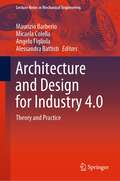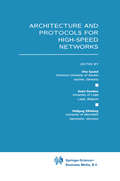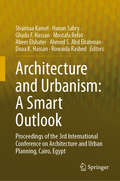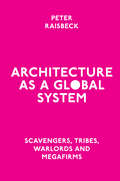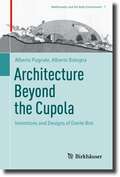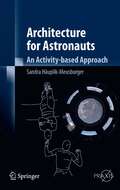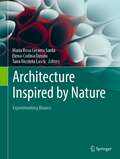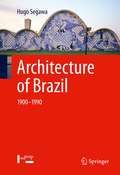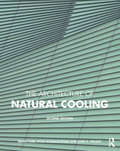- Table View
- List View
Architecture and Design for Industry 4.0: Theory and Practice (Lecture Notes in Mechanical Engineering)
by Maurizio Barberio Micaela Colella Angelo Figliola Alessandra BattistiThis book collects contributions of forefront research and practices related to the use of the enabling technologies of Industry 4.0 in the architecture and design fields and their impact on the UN's Sustainable Developments goals. The book is structured into three sections (research, practice, and technologies), with the goal of creating a new framework useful for widespread awareness necessary to initiate technology transfer processes for the benefit of the public sector, universities, research centers, and innovative companies, and a new professional figure capable of controlling the entire process is essential. Thus, the book chapters arouse a series of relevant topics such as computational and parametric design, performance-based architecture, data-driven design strategies, parametric environmental design and analysis, computational and parametric structural design and analysis, AI and machine learning, BIM and interoperability, VR and AR, digital and robotic fabrication, additive manufacturing and 3D printing, R&D and entrepreneurship, circular architecture, and didactics. In the post-digital era, where the essence of design lies in the control and information of the process that holistically involves all the aspects mentioned above, rather than in formal research, it is necessary to understand technologies and analyze the advantages that they can bring in terms of environmental sustainability and product innovation.
Architecture and Design for the Future Internet: 4WARD Project (Signals and Communication Technology)
by Luis M. M. Correia, Henrik Abramowicz, Martin Johnsson and Klaus WünstelArchitecture and Design for the Future Internet addresses the Networks of the Future and the Future Internet, focusing on networks aspects, offering both technical and non-technical perspectives. It presents the main findings of 4WARD (Architecture and Design for the Future Internet), a European Integrated Project within Framework Programme 7, which addressed this area from an innovative approach. Today’s network architectures are stifling innovation, restricting it mostly to the application level, while the need for structural change is increasingly evident. The absence of adequate facilities to design, optimise and interoperate new networks currently forces a convergence to an architecture that is suboptimal for many applications and that cannot support innovations within itself, the Internet. 4WARD overcomes this impasse through a set of radical architectural approaches, built on a strong mobile and wireless background. The main topics addressed by the book are: the improved ability to design inter-operable and complementary families of network architectures; the enabled co-existence of multiple networks on common platforms through carrier-grade virtualisation for networking resources; the enhanced utility of networks by making them self-managing; the increased robustness and efficiency of networks by leveraging diversity; and the improved application support by a new information-centric paradigm in place of the old host-centric approach. These solutions embrace the full range of technologies, from fibre backbones to wireless and sensor networks.
Architecture and Design of Molecule Logic Gates and Atom Circuits: Proceedings of the 2nd AtMol European Workshop (Advances in Atom and Single Molecule Machines)
by Nicolas Lorente and Christian JoachimHave you ever puzzled over how to perform Boolean logic at the atomic scale? Or wondered how you can carry out more general calculations in one single molecule or using a surface dangling bond atomic scale circuit? This volume gives you an update on the design of single molecule devices, such as recitfiers, switches and transistors, more advanced semi-classical and quantum boolean gates integrated in a single molecule or constructed atom by atom on a passivated semi-conductor surface and describes their interconnections with adapted nano-scale wiring. The main contributors to the field of single molecule logic gates and surface dangling bond atomic scale circuits theory and design, were brought together for the first time to contribute on topics such as molecule circuits, surface dangling bond circuits, quantum controlled logic gates and molecular qubits. Contributions in this volume originate from the Barcelona workshop of the AtMol conference series, held from January 12-13 2012.
Architecture and Governance for Communication Services
by Noël Crespi Emmanuel BertinCommunication services are evolving at an unprecedented rate. No longer limited to interpersonal vocal communication, they now integrate functions such as address books, content sharing and messaging. The emergence of social networks – which may also include these features – is an important element of this transformation. Content services are becoming flagship services themselves, and are sometimes paired up with conversation services. The boundaries between different services are becoming less and less distinct. This book meets the need for a better understanding of communication services, and for a general framework of their description. A detailed overview on service architecture in the Telco, Web and IT worlds is presented, offering a roadmap with explanations on how to improve the architecture and governance of communication service architectures by exploiting the syntax and semantics that are common to different services is clearly outlined. This book also responds to recurring questions about service design, such as the functional scope of enablers or SOA (Service Oriented Architecture) services, the relevance of service composition to the user and collaboration between different services in a converged environment. Many concrete examples from telecoms service providers’ operations illustrate these concepts. Contents 1. Describing Service Architectures. 2. Convergence of Service. 3. Building an Architectural Framework for Telecom Services. 4. Modeling and Case Study. 5. Organizational and Software Applications. About the Authors Emmanuel Bertin is senior service architect at Orange Labs in France. He is the author of more than 40 research papers, and holds more than 10 patents in the area of communication services. Noël Crespi worked at Bouygues Telecom, France Telecom R&D, and then at Nortel Networks where he led the Telephony Programme. He is currently Professor and Head of the Service Architecture Laboratory at Institut Mines-Telecom, Telecom SudParis in France and is the author/co-author of more than 160 research papers and 140 contributions in standardization.
Architecture and Governance for Communication Services
by Noël Crespi Emmanuel BertinCommunication services are evolving at an unprecedented rate. No longer limited to interpersonal vocal communication, they now integrate functions such as address books, content sharing and messaging. The emergence of social networks – which may also include these features – is an important element of this transformation. Content services are becoming flagship services themselves, and are sometimes paired up with conversation services. The boundaries between different services are becoming less and less distinct. This book meets the need for a better understanding of communication services, and for a general framework of their description. A detailed overview on service architecture in the Telco, Web and IT worlds is presented, offering a roadmap with explanations on how to improve the architecture and governance of communication service architectures by exploiting the syntax and semantics that are common to different services is clearly outlined. This book also responds to recurring questions about service design, such as the functional scope of enablers or SOA (Service Oriented Architecture) services, the relevance of service composition to the user and collaboration between different services in a converged environment. Many concrete examples from telecoms service providers’ operations illustrate these concepts. Contents 1. Describing Service Architectures. 2. Convergence of Service. 3. Building an Architectural Framework for Telecom Services. 4. Modeling and Case Study. 5. Organizational and Software Applications. About the Authors Emmanuel Bertin is senior service architect at Orange Labs in France. He is the author of more than 40 research papers, and holds more than 10 patents in the area of communication services. Noël Crespi worked at Bouygues Telecom, France Telecom R&D, and then at Nortel Networks where he led the Telephony Programme. He is currently Professor and Head of the Service Architecture Laboratory at Institut Mines-Telecom, Telecom SudParis in France and is the author/co-author of more than 160 research papers and 140 contributions in standardization.
Architecture and Principles of Systems Engineering
by Charles Dickerson Dimitri N. MavrisThe rapid evolution of technical capabilities in the systems engineering (SE) community requires constant clarification of how to answer the following questions: What is Systems Architecture? How does it relate to Systems Engineering? What is the role of a Systems Architect? How should Systems Architecture be practiced?A perpetual reassessment of c
Architecture and Protocols for High-Speed Networks
by Otto Spaniol Andre Danthine Wolfgang EffelsbergMultimedia data streams will form a major part of the new generation of applications in high-speed networks. Continuous media streams, however, require transmission with guaranteed performance. In addition, many multimedia applications will require peer-to-multipeer communication. Guaranteed performance can only be provided with resource reservation in the network, and efficient multipeer communication must be based on multicast support in the lower layers of the network. Architecture and Protocols for High-Speed Networks focuses on techniques for building the networks that will meet the needs of these multimedia applications. In particular two areas of current research interest in such communication systems are covered in depth. These are the protocol related aspects, such as switched networks, ATM, MAC layer, network and transport layer; and the services and applications. Architecture and Protocols for High-Speed Networks contains contributions from leading world experts, giving the most up-to-date research available. It is an essential reference for all professionals, engineers and researchers working in the area of high-speed networks.
Architecture and Urbanism: Proceedings of the 3rd International Conference on Architecture and Urban Planning, Cairo, Egypt
by Shaimaa Kamel Hanan Sabry Ghada F. Hassan Mostafa Refat Abeer Elshater Ahmed S. Abd Elrahman Doaa K. Hassan Rowaida RashedThis proceedings addresses the challenges of urbanization that gravely affect the world’s ecosystems. To become efficiently sustainable and regenerative, buildings and cities need to adopt smart solutions. This book discusses innovations of the built environment while depicting how such practices can transform future buildings and urban areas into places of higher value and quality. The book aims to examine the interrelationship between people, nature and technology, which is essential in pursuing smart environments that optimize human wellbeing, motivation and vitality, as well as promoting cohesive and inclusive societies: Urban Sociology - Community Involvement - Place-making and Cultural Continuity – Environmental Psychology - Smart living - Just City. The book presents exemplary practical experiences that reflect smart strategies, technologies and innovations, by established and emerging professionals, provides a forum of real-life discourse. The primary audience for the work will be from the fields of architecture, urban planning and built-environment systems, including multi-disciplinary academics as well as professionals.
Architecture as a Global System: Scavengers, Tribes, Warlords and Megafirms
by Peter RaisbeckSince the 1980s the architectural profession across the world has been driven by globalisation. The factors shaping this globalisation include neo-liberal economics, digital transformation and the rise of social media against the background of the profession’s entrenched labour practices. In describing architecture as a global system, this book outlines how globalisation has shaped architecture and explores the degree to which architecture remains a distinct field of knowledge. The book identifies four categories of architects in this global system: scavengers, tribes, warlords and megafirms. By employing this institutional-logics approach, the author looks beyond the surface spectacle of iconic projects, celebrity architects and cycles of urban focused media outrage. From this perspective, the book illuminates the archipelagos and outposts of disciplinary knowledge that architectural actors traverse and highlights the frontiers at which architectural knowledge is both created and eroded. The author argues that to retain their future agency, architects must understand the contours and ecologies of practice that constitute this global system of architectural production. This book provides a clear-sighted analysis to suggest the points that need reconfiguring in this global system so that architects may yet shape and order the future of cities.
Architecture as a Global System: Scavengers, Tribes, Warlords and Megafirms
by Peter RaisbeckSince the 1980s the architectural profession across the world has been driven by globalisation. The factors shaping this globalisation include neo-liberal economics, digital transformation and the rise of social media against the background of the profession’s entrenched labour practices. In describing architecture as a global system, this book outlines how globalisation has shaped architecture and explores the degree to which architecture remains a distinct field of knowledge. The book identifies four categories of architects in this global system: scavengers, tribes, warlords and megafirms. By employing this institutional-logics approach, the author looks beyond the surface spectacle of iconic projects, celebrity architects and cycles of urban focused media outrage. From this perspective, the book illuminates the archipelagos and outposts of disciplinary knowledge that architectural actors traverse and highlights the frontiers at which architectural knowledge is both created and eroded. The author argues that to retain their future agency, architects must understand the contours and ecologies of practice that constitute this global system of architectural production. This book provides a clear-sighted analysis to suggest the points that need reconfiguring in this global system so that architects may yet shape and order the future of cities.
Architecture-Aware Optimization Strategies in Real-time Image Processing
by Chao Li Souleymane Balla-Arabe Fan YangIn the field of image processing, many applications require real-time execution, particularly those in the domains of medicine, robotics and transmission, to name but a few. Recent technological developments have allowed for the integration of more complex algorithms with large data volume into embedded systems, in turn producing a series of new sophisticated electronic architectures at affordable prices. This book performs an in-depth survey on this topic. It is primarily written for those who are familiar with the basics of image processing and want to implement the target processing design using different electronic platforms for computing acceleration. The authors present techniques and approaches, step by step, through illustrative examples. This book is also suitable for electronics/embedded systems engineers who want to consider image processing applications as sufficient imaging algorithm details are given to facilitate their understanding.
Architecture-Aware Optimization Strategies in Real-time Image Processing
by Chao Li Souleymane Balla-Arabe Fan YangIn the field of image processing, many applications require real-time execution, particularly those in the domains of medicine, robotics and transmission, to name but a few. Recent technological developments have allowed for the integration of more complex algorithms with large data volume into embedded systems, in turn producing a series of new sophisticated electronic architectures at affordable prices. This book performs an in-depth survey on this topic. It is primarily written for those who are familiar with the basics of image processing and want to implement the target processing design using different electronic platforms for computing acceleration. The authors present techniques and approaches, step by step, through illustrative examples. This book is also suitable for electronics/embedded systems engineers who want to consider image processing applications as sufficient imaging algorithm details are given to facilitate their understanding.
Architecture-Based Design of Multi-Agent Systems
by Danny WeynsMulti-agent systems are claimed to be especially suited to the development of software systems that are decentralized, can deal flexibly with dynamic conditions, and are open to system components that come and go. This is why they are used in domains such as manufacturing control, automated vehicles, and e-commerce markets. Danny Weyns' book is organized according to the postulate that "developing multi-agent systems is 95% software engineering and 5% multi-agent systems theory." He presents a software engineering approach for multi-agent systems that is heavily based on software architecture - with, for example, tailored patterns such as "situated agent", "virtual environment", and "selective perception" - and on middleware for distributed coordination – with programming abstractions such as "views" and "roles." Next he shows the feasibility and applicability of this approach with the development of an automated transportation system consisting of a number of automatic guided vehicles transporting loads in an industrial setting. Weyns puts the development of multi-agent systems into a larger perspective with traditional software engineering approaches. With this, he opens up opportunities to exploit the body of knowledge developed in the multi-agent systems community to tackle some of the difficult challenges of modern-day software systems, such as decentralized control, location-awareness, self-adaption, and large-scale. Thus his book is of interest for both researchers and industrial software engineers who develop applications in areas such as distributed control systems and mobile applications where such requirements are of crucial importance.
Architecture Beyond the Cupola: Inventions and Designs of Dante Bini (Mathematics and the Built Environment #7)
by Alberto Pugnale Alberto BolognaThis book reviews Dante Bini’s inventions and designs, focusing on his form-resistant Binishell and other pneumatic construction systems. Dante Bini’s double profile of architect and builder underpins the narrative of the entire book. It is used to analyse the evolution of the early reinforced-concrete Binishell patent into a variety of automated construction systems based on the use of air. Dante Bini has always been quite proactive in promoting his work and disseminating the results of his experimentations and achievements via journal articles, conference presentations and public talks; promotional brochures in multiple languages were also prepared to export and license his patents in various countries, from Italy to the Americas and Australia. Despite this, a rigorous study of Dante Bini’s work is still unavailable, and the relevance of this figure to contemporary architecture has yet to be discussed comprehensively. This book fills in this gap and arrives at the right time: during the last two decades, there has been an exponential interest in shell and spatial structures, particularly concerning the use of complex geometries and innovative construction techniques. This book will be of interest to academics in architectural design, theory and construction history, and practitioners and students interested in expanding their knowledge in the design and construction of shell and spatial structures.
Architecture Exploration for Embedded Processors with LISA
by Andreas Hoffmann Heinrich Meyr Rainer LeupersToday more than 90% of all programmable processors are employed in embedded systems. The LISA processor design platform presented in this book addresses recent design challenges and results in highly satisfactory solutions, covering all major high-level phases of embedded processor design.
Architecture Exploration of FPGA Based Accelerators for BioInformatics Applications (Springer Series in Advanced Microelectronics #55)
by B. Sharat Varma Kolin Paul M. BalakrishnanThis book presents an evaluation methodology to design future FPGA fabrics incorporating hard embedded blocks (HEBs) to accelerate applications. This methodology will be useful for selection of blocks to be embedded into the fabric and for evaluating the performance gain that can be achieved by such an embedding. The authors illustrate the use of their methodology by studying the impact of HEBs on two important bioinformatics applications: protein docking and genome assembly. The book also explains how the respective HEBs are designed and how hardware implementation of the application is done using these HEBs. It shows that significant speedups can be achieved over pure software implementations by using such FPGA-based accelerators. The methodology presented in this book may also be used for designing HEBs for accelerating software implementations in other domains besides bioinformatics. This book will prove useful to students, researchers, and practicing engineers alike.
Architecture for Astronauts: An Activity-based Approach (Springer Praxis Books)
by Sandra Häuplik-MeusburgerLiving and working in extra-terrestrial habitats means being potentially vulnerable to very harsh environmental, social, and psychological conditions. With the stringent technical specifications for launch vehicles and transport into space, a very tight framework for the creation of habitable space is set. These constraints result in a very demanding “partnership” between the habitat and the inhabitant. This book is the result of researching the interface between people, space and objects in an extra-terrestrial environment. The evaluation of extra-terrestrial habitats in comparison to the user’s perspective leads to a new framework, comparing these buildings from the viewpoint of human activity. It can be used as reference or as conceptual framework for the purpose of evaluation. It also summarizes relevant human-related design directions. The work is addressed to architects and designers as well as engineers.
Architecture Inspired by Nature: Experimenting Bionics
by María Rosa Cervera Sardá Elena-Codina Dușoiu Tana Nicoleta LascuThe book brings together the research completed during 10 editions of International Seminars of Bionics, organized by the School of Architecture of the University of Alcalá de Henares, Madrid, several of them in partnership with the “Ion Mincu” University of Architecture and Urbanism, Bucharest, carried out in Spain and in Romania. The articles here consider advanced bionic design principles, implementing them to an impressive variety of application fields, including, but not limited to, urban planning and landscape, public space, architecture and building structures, design and detailing, application of natural dynamic processes, bio-digital architecture, innovative materials based on living organisms (micro-algae), and nano-modified materials. A particular focus is given to light and perception of light. To illustrate the principles developed, this contributed volume includes descriptions and full-color images of the experimental projects created during the workshops held in the framework of these ISB meetings: Learning from Nature, Integrating Bionics (2009); Adaptability, Efficiency and Biostructures (2010); Bionics and Innovation (2011); Forms and Structures Inspired by Nature (2016, 2017); Furniture Inspired by Natural Models (2018); Relation between Structure and Envelope: Light Structures (2019); Light, from Nature to Architecture. Structures Inspired in Nature (2020); Light in Architecture and Design: A Bionic Perspective (2021); Sustainable Thinking and Bionics (2022).
Architecture of Brazil: 1900-1990
by Hugo SegawaArchitecture of Brazil: 1900-1990 examines the processes that underpin modern Brazilian architecture under various influences and characterizes different understandings of modernity, evident in the chapter topics of this book. Accordingly, the author does not give overall preference to particular architects nor works, with the exception of a few specific works and architects, including Warchavchik, Niemeyer, Lucio Costa, and Vilanova Artigas.
The Architecture of Natural Cooling
by Brian Ford Rosa Schiano-Phan Juan A. VallejoOverheating in buildings is commonplace. This book describes how we can keep cool without conventional air-conditioning: improving comfort and productivity while reducing energy costs and carbon emissions. It provides architects, engineers and policy makers with a ‘how-to’ guide to the application of natural cooling in new and existing buildings. It demonstrates, through reference to numerous examples, that natural cooling is viable in most climates around the world. This completely revised and expanded second edition includes: An overview of natural cooling past and present. Guidance on the principles and strategies that can be adopted. A review of the applicability of different strategies. Explanation of simplified tools for performance assessment. A review of components and controls. A detailed evaluation of case studies from the USA, Europe, India and China. This book is not just for the technical specialist, as it also provides a general grounding in how to avoid or minimise air-conditioning. Importantly, it demonstrates that understanding our environment, rather than fighting it, will help us to live sustainably in our rapidly warming world.
The Architecture of Natural Cooling
by Brian Ford Rosa Schiano-Phan Juan A. VallejoOverheating in buildings is commonplace. This book describes how we can keep cool without conventional air-conditioning: improving comfort and productivity while reducing energy costs and carbon emissions. It provides architects, engineers and policy makers with a ‘how-to’ guide to the application of natural cooling in new and existing buildings. It demonstrates, through reference to numerous examples, that natural cooling is viable in most climates around the world. This completely revised and expanded second edition includes: An overview of natural cooling past and present. Guidance on the principles and strategies that can be adopted. A review of the applicability of different strategies. Explanation of simplified tools for performance assessment. A review of components and controls. A detailed evaluation of case studies from the USA, Europe, India and China. This book is not just for the technical specialist, as it also provides a general grounding in how to avoid or minimise air-conditioning. Importantly, it demonstrates that understanding our environment, rather than fighting it, will help us to live sustainably in our rapidly warming world.
The Architecture of Student-Oriented Course Design: Building a Course for Contemporary Higher Education Students
by Nicholas JacksonIncorporating a range of practical insights and tools, this innovative book presents a unique perspective on course design that considers the needs and expectations of contemporary university students. Nicholas Jackson explains how to improve student confidence and engagement by designing inclusive courses that center students in their learning.The Architecture of Student-Oriented Course Design builds on a strong theoretical framework as well as empirical insights from the classroom, illustrating how to maximize active participation and deep learning. Jackson provides a step-by-step plan to constructively align learning outcomes, course content and forms of assessment. Considering current challenges in higher education such as socio-economic pressures from a student perspective, Jackson highlights practical interventions and emphasizes the importance of design structure with a special focus on developing employability skills. From lectures to group assignments, this book will aid in designing interesting and thought-provoking courses that are aligned with the needs of today’s higher education learners.This book is indispensable to students and scholars of management education, teaching and learning, education administration, curriculum and pedagogy, and educational assessment. It is also beneficial to both early-career and established academics wishing to refresh their courses.
Architecture of Systems Problem Solving
by George J. KlirOne criterion for classifying books is whether they are written for a single purpose or for multiple purposes. This book belongs to the category of multipurpose books, but one of its roles is predominant-it is primarily a textbook. As such, it can be used for a variety of courses at the first-year graduate or upper-division undergraduate level. A common characteristic of these courses is that they cover fundamental systems concepts, major categories of systems problems, and some selected methods for dealing with these problems at a rather general level. A unique feature of the book is that the concepts, problems, and methods are introduced in the context of an architectural formulation of an expert system referred to as the general systems problem solver or GSPS-whose aim is to provide users of all kinds with computer-based systems knowledge and methodology. The GSPS architecture, which is developed throughout the book, facilitates a framework that is conducive to a coherent, comprehensive, and pragmatic coverage of systems fundamentals--concepts, problems, and methods. A course that covers systems fundamentals is now offered not only in systems ~cience, information science, or systems engineering programs, but in many programs in other disciplines as well. Although the level of coverage for systems science or engineering students is surely different from that used for students in other disciplines, this book is designed to serve both of these needs.
Architectured Materials in Nature and Engineering: Archimats (Springer Series in Materials Science #282)
by Yuri Estrin Yves Bréchet John Dunlop Peter FratzlThis book deals with a group of architectured materials. These are hybrid materials in which the constituents (even strongly dissimilar ones) are combined in a given topology and geometry to provide otherwise conflicting properties. The hybridization presented in the book occurs at various levels - from the molecular to the macroscopic (say, sub-centimeter) ones. This monograph represents a collection of programmatic chapters, defining archimats and summarizing the results obtained by using the geometry-inspired materials design. The area of architectured or geometry-inspired materials has reached a certain level of maturity and visibility for a comprehensive presentation in book form. It is written by a group of authors who are active researchers working on various aspects of architectured materials. Through its 14 chapters, the book provides definitions and descriptions of the archetypes of architectured materials and addresses the various techniques in which they can be designed, optimized, and manufactured. It covers a broad realm of archimats, from the ones occurring in nature to those that have been engineered, and discusses a range of their possible applications. The book provides inspiring and scientifically profound, yet entertaining, reading for the materials science community and beyond.
Architectures and Synthesizers for Ultra-low Power Fast Frequency-Hopping WSN Radios (Analog Circuits and Signal Processing)
by Emanuele Lopelli Johan van der Tang Arthur H.M. van RoermundWireless sensor networks have the potential to become the third wireless revolution after wireless voice networks in the 80s and wireless data networks in the late 90s. Unfortunately, radio power consumption is still a major bottleneck to the wide adoption of this technology. Different directions have been explored to minimize the radio consumption, but the major drawback of the proposed solutions is a reduced wireless link robustness.The primary goal of Architectures and Synthesizers for Ultra-low Power Fast Frequency-Hopping WSN Radios is to discuss, in detail, existing and new architectural and circuit level solutions for ultra-low power, robust, uni-directional and bi-directional radio links.Architectures and Synthesizers for Ultra-low Power Fast Frequency-Hopping WSN Radios guides the reader through the many system, circuit and technology trade-offs he will be facing in the design of communication systems for wireless sensor networks. Finally, this book, through different examples realized in both advanced CMOS and bipolar technologies opens a new path in the radio design, showing how radio link robustness can be guaranteed by techniques that were previously exclusively used in radio systems for middle or high end applications like Bluetooth and military communications while still minimizing the overall system power consumption.
